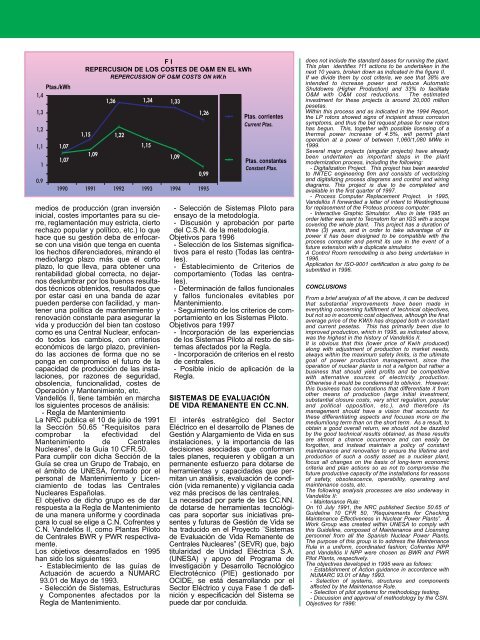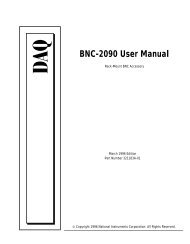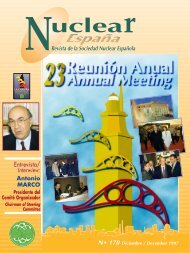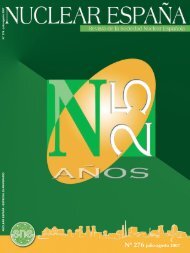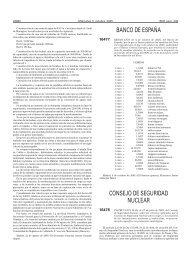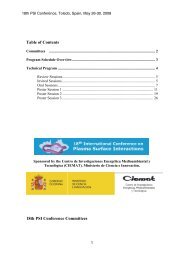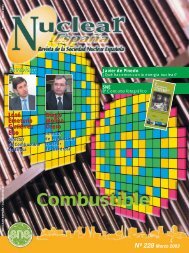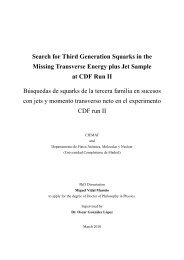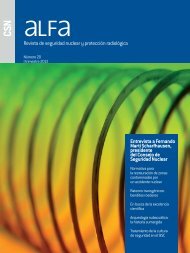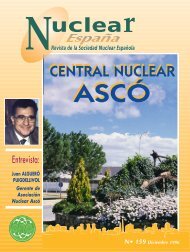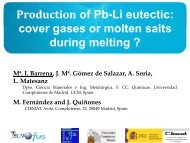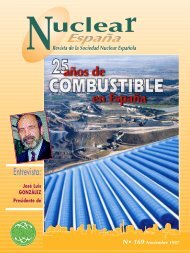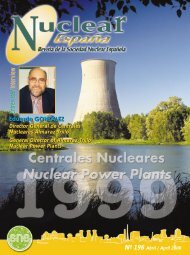Create successful ePaper yourself
Turn your PDF publications into a flip-book with our unique Google optimized e-Paper software.
Ptas./kWh1,41,31,21,110.91,07JB1,07F IREPERCUSION DE LOS COSTES DE O&M EN EL kWhREPERCUSSION OF O&M COSTS ON kW.h1,15BJ1,091,36 B 1,34 1,33BBmedios de producción (gran inversióninicial, costes importantes para su cierre,reglamentación muy estricta, ciertorechazo popular y político, etc.) lo quehace que su gestión deba de enfocarsecon una visión que tenga en cuentalos hechos diferenciadores, mirando elmedio/largo plazo más que el cortoplazo, lo que lleva, para obtener unarentabilidad global correcta, no dejarnosdeslumbrar por los buenos resultadostécnicos obtenidos, resultados quepor estar casi en una banda de azarpueden perderse con facilidad, y manteneruna política de mantenimiento yrenovación constante para asegurar lavida y producción del bien tan costosocomo es una Central Nuclear, enfocandotodos los cambios, con criterioseconómicos de largo plazo, previniendolas acciones de forma que no seponga en compromiso el futuro de lacapacidad de producción de las instalaciones,por razones de seguridad,obsolencia, funcionalidad, costes deOperación y Mantenimiento, etc.Vandellós II, tiene también en marchalos siguientes procesos de análisis:- Regla de MantenimientoLa NRC publica el 10 de julio de 1991la Sección 50.65 “Requisitos paracomprobar la efectividad delMantenimiento de CentralesNucleares”, de la Guía 10 CFR.50.Para cumplir con dicha Sección de laGuía se crea un Grupo de Trabajo, enel ámbito de UNESA, formado por elpersonal de Mantenimiento y Licenciamientode todas las CentralesNucleares Españolas.El objetivo de dicho grupo es de darrespuesta a la Regla de Mantenimientode una manera uniforme y coordinadapara lo cual se elige a C.N. Cofrentes yC.N. Vandellós II, como Plantas Pilotode Centrales BWR y PWR respectivamente.Los objetivos desarrollados en 1995han sido los siguientes:- Establecimiento de las guías deActuación de acuerdo a NUMARC93.01 de Mayo de 1993.- Selección de Sistemas, Estructurasy Componentes afectados por laRegla de Mantenimiento.J1,22J1,15J1,091,26BJ0,991990 1991 1992 1993 1994 1995BJPtas. corrientesCurrent Ptas.Ptas. constantesConstant Ptas.- Selección de Sistemas Piloto paraensayo de la metodología.- Discusión y aprobación por partedel C.S.N. de la metodología.Objetivos para 1996- Selección de los Sistemas significativospara el resto (Todas las centrales).- Establecimiento de Criterios decomportamiento (Todas las centrales).- Determinación de fallos funcionalesy fallos funcionales evitables porMantenimiento.- Seguimiento de los criterios de comportamientoen los Sistemas Piloto.Objetivos para 1997- Incorporación de las experienciasde los Sistemas Piloto al resto de sistemasafectados por la Regla.- Incorporación de criterios en el restode centrales.- Posible inicio de aplicación de laRegla.SISTEMAS DE EVALUACIÓNDE VIDA REMANENTE EN CC.NN.El interés estratégico del SectorEléctrico en el desarrollo de Planes deGestión y Alargamiento de Vida en susinstalaciones, y la importancia de lasdecisiones asociadas que conformantales planes, requieren y obligan a unpermanente esfuerzo para dotarse deherramientas y capacidades que permitanun análisis, evaluación de condición(vida remanente) y vigilancia cadavez más precisos de las centrales.La necesidad por parte de las CC.NN.de dotarse de herramientas tecnológicaspara soportar sus iniciativas presentesy futuras de Gestión de Vida seha traducido en el Proyecto ¨Sistemasde Evaluación de Vida Remanente deCentrales Nucleares” (SEVR) que, bajotitularidad de Unidad Eléctrica S.A.(UNESA) y apoyo del Programa deInvestigación y Desarrollo TecnológicoElectrotécnico (PIE) gestionado porOCIDE, se está desarrollando por elSector Eléctrico y cuya Fase 1 de definicióny especificación del Sistema sepuede dar por concluida.does not include the standard bases for running the plant.This plan identifies 111 actions to be undertaken in thenext 10 years, broken down as indicated in the figure II.If we divide them by cost criteria, we see that 38% areintended to increase power and reduce AutomaticShutdowns (Higher Production) and 33% to facilitateO&M with O&M cost reductions. The estimatedinvestment for these projects is around 20,000 millionpesetas.Within this process and as indicated in the 1994 Report,the LP rotors showed signs of incipient stress corrosionsymptoms, and thus the bid request phase for new rotorshas begun. This, together with possible licensing of athermal power increase of 4.5%, will permit plantoperation at a power of between 1,060/1,080 MWe in1999.Several major projects (singular projects) have alreadybeen undertaken as important steps in the plantmodernization process, including the following:- Digitalization Project. This project has been awardedto INITEC engineering firm and consists of vectorizingand digitalizing process diagrams and control and wiringdiagrams. This project is due to be completed andavailable in the first quarter of 1997.- Process Computer Replacement Project. In 1995,Vandellós II forwarded a letter of intent to Westinghousefor replacement of the Proteus process computer.- Interactive Graphic Simulator. Also in late 1995 anorder letter was sent to Tecnatom for an IGS with a scopecovering the whole plant. This project has a duration ofthree (3) years, and in order to take advantage of itspower it has been designed to be compatible with theprocess computer and permit its use in the event of afuture extension with a duplicate simulator.A Control Room remodelling is also being undertaken in1996.Application for ISO-9001 certification is also going to besubmitted in 1996.CONCLUSIONSFrom a brief analysis of all the above, it can be deducedthat substantial improvements have been made ineverything concerning fulfillment of technical objectives,but not so in economic cost objectives, although the finalaverage price of the KW/h has dropped both in constantand current pesetas. This has primarily been due toimproved production, which in 1995, as indicated above,was the highest in the history of Vandellós II.It is obvious that this (lower price of Kw/h produced)along with adjustment of production to market needs,always within the maximum safety limits, is the ultimategoal of power production management, since theoperation of nuclear plants is not a religion but rather abusiness that should yield profits and be competitivewith alternative sources of electricity production.Otherwise it would be condemned to oblivion. However,this business has connotations that differentiate it fromother means of production (large initial investment,substantial closure costs, very strict regulation, popularand political opposition, etc.), and therefore itsmanagement should have a vision that accounts forthese differentiating aspects and focuses more on themedium/long term than on the short term. As a result, toobtain a good overall return, we should not be dazzledby the good technical results obtained, as these resultsare almost a chance occurrence and can easily beforgotten, and instead maintain a policy of constantmaintenance and renovation to ensure the lifetime andproduction of such a costly asset as a nuclear plant,focus all changes on the basis of long-term economiccriteria and plan actions so as not to compromise thefuture productive capacity of the installations for reasonsof safety, obsolescence, operability, operating andmaintenance costs, etc.The following analysis processes are also underway inVandellós II:- Maintenance Rule:On 10 July 1991, the NRC published Section 50.65 ofGuideline 10 CFR 50, “Requirements for CheckingMaintenance Effectiveness in Nuclear Power Plants”. AWork Group was created within UNESA to comply withthis Guideline, composed of Maintenance and Licensingpersonnel from all the Spanish Nuclear Power Plants.The purpose of this group is to address the MaintenanceRule in a uniform, coordinated fashion; Cofrentes NPPand Vandellós II NPP were chosen as BWR and PWRPilot Plants, respectively.The objectives developed in 1995 were as follows:- Establishment of Action guidance in accordance withNUMARC 93.01 of May 1993.- Selection of systems, structures and componentsaffected by the Maintenance Rule.- Selection of pilot systems for methodology testing.- Discussion and approval of methodology by the CSN.Objectives for 1996:


